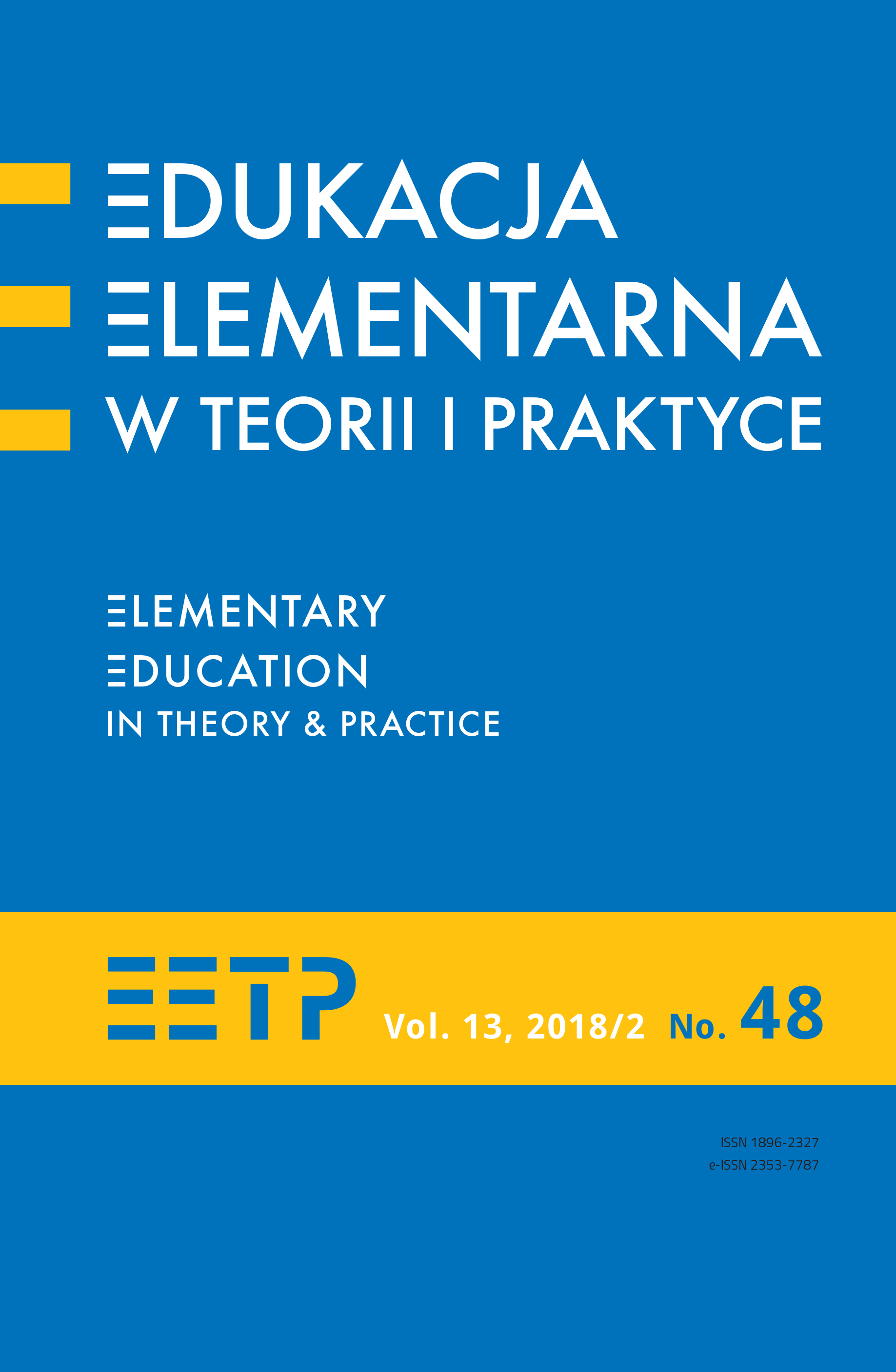Rozumienie i istota twórczości językowej dzieci
Abstrakt
Celem artykułu jest przybliżenie rozumienia oraz istoty twórczości językowej dziecka. Język jest narzędziem umożliwiającym poznanie otaczającej człowieka rzeczywistości. To dzięki niemu nazywamy przedmioty, obiekty, zjawiska, a także określamy zaobserwowane i przeżywane czynności oraz stany. Język pozwala wyrażać doznawane emocje i nastawienie do innych. Dziecko w sposób naturalny manipuluje językiem, bawi się nim, co wskazuje na jego twórczość językową, która jest umiejętnością przekształcania usłyszanych wypowiedzi oraz wytwarzania własnych, nowych i oryginalnych pod względem treści, formy i sposobu ekspresji. Na początku artykułu przedstawiono definicje twórczości oraz płaszczyzny rozumienia twórczości dziecięcej, tj. podejście elitarne oraz egalitarne do twórczości. Następnie nakreślono znaczenie języka w życiu jednostki oraz umiejętnego manipulowania nim. W dalszej części skupiono się na inteligencji lingwistycznej według Howarda Gardnera oraz wyznacznikach aktywności językowej dziecka w zakresie twórczości semantycznej, syntaktycznej, leksykalnej i tekstowej. Na koniec zamieszczono przykłady twórczych wytworów dziecięcych. Tekst ukazuje różne podejścia do twórczości językowej dziecka oraz podkreśla istotę twórczej aktywności w życiu każdego człowieka.
Bibliografia
Borawska K., Umiejętności językowe dziecka kończącego edukację wczesnoszkolną, Trans Humana, Białystok 2004.
Cudowska A., Kształtowanie twórczych orientacji życiowych w procesie edukacji, Trans Humana, Białystok 2004.
Czelakowska D., Twórczość a kształcenie języka dzieci w wieku wczesnoszkolnym, Wydawnictwo Impuls, Kraków 1996.
Filipiak E., Aktywność językowa dzieci w wieku wczesnoszkolnym, Wydawnictwo Uczelniane WSP, Bydgoszcz 1996.
Filipiak E., Aktywność werbalna dzieci w pierwszym, drugim i trzecim roku edukacji, Zeszyty Naukowe Wyższej Szkoły Pedagogicznej w Bydgoszczy, „Studia Pedagogiczne”, 1997 33(13).
Filipiak E., Konteksty rozwoju aktywności językowej dzieci w wieku wczesnoszkolnym, Wydawnictwo Akademii Bydgoskiej, Bydgoszcz 2002.
Gardner H., Inteligencje wielorakie. Teoria w praktyce, Media Rodzina, Poznań 2002.
Gloton R., Clero C., Twórcza aktywność dziecka, przeł. I. Wojnar, WSiP, Warszawa 1976.
Kielar M., Twórcze opanowywanie i używanie języka przez dziecko, [w:] Aktywność twórcza dzieci i młodzieży, red. S. Popek, WSiP, Warszawa 1988.
Magda-Adamowicz M., Children’s Creativity in a Systemic Perspective, Wydawnictwo Adam Marszałek, Toruń 2013.
Magda-Adamowicz M., Obraz twórczych pedagogicznie nauczycieli, Wydawnictwo Adam Marszałek, Toruń 2012.
Magda-Adamowicz M. (red.), Twórczość dzieci we wczesnej edukacji, Wyższa Szkoła Menedżerska w Legnicy, Legnica 2005.
Magda-Adamowicz M., Twórczość pedagogiczna nauczycieli w kontekście systemowym. Źródła, koncepcja i identyfikacje, Wydawnictwo Adam Marszałek, Toruń 2015.
Magda-Adamowicz M., Uwarunkowania efektywności kształcenia nauczycieli klas I–III w zakresie twórczości pedagogicznej, Oficyna Wydawnicza Uniwersytetu Zielonogórskiego, Zielona Góra 2009.
Sulma B., Możliwości i sposoby rozwijania twórczej aktywności językowej dzieci w wieku przedszkolnym; http://www.profesor.pl/mat/pd7/pd7_b_sulma_20070525_2.pdf (dostęp: 27.02.2018).
Suświłło M., Inteligencje wielorakie w nowoczesnym kształceniu, Wydawnictwo UWM, Olsztyn 2004.
Stawinoga R., Twórczość językowa dziecka w teorii i praktyce edukacyjnej, Wydawnictwo UMCS, Lublin 2007.
Szmidt K.J., Pedagogika twórczości, Gdańskie Wydawnictwo Psychologiczne, Sopot 2013.
Tatarkiewicz W., Dzieje sześciu pojęć, Wydawnictwo Naukowe PWN, Warszawa 2004.
Warsicka A., Rozwijanie twórczej aktywności językowej uczniów klas początkowych, [w:] Twórcza aktywność uczniów klas początkowych, red. M. Jakowicka, J. Kujawiński, Wyższa Szkoła Pedagogiczna, Zielona Góra 1989.
Zgółkowa H., Czym język za młodu nasiąknie…, Wydawnictwo Poznańskie, Poznań 1986.
http://czaszdziecmi.pl/advices/rozrywkowo/show/328–zagadki-i-lamiglowki (dostęp: 15.02.2018).
http://www.tkj.uw.edu.pl/poradnia/art09.htm (dostęp: 15.02.2018).
Copyright (c) 2018 Edukacja Elementarna w Teorii i Praktyce

Utwór dostępny jest na licencji Creative Commons Uznanie autorstwa – Bez utworów zależnych 4.0 Międzynarodowe.
1. Autor zgłaszając swój artykuł oświadcza, że jest Autorem artykułu (zwanego dalej Utworem) i:
- przysługują mu wyłączne i nieograniczone prawa autorskie do Utworu,
- jest uprawniony/a do rozporządzania prawami autorskimi do Utworu.
Oświadcza, że nie narusza praw autorskich osób trzecich i praw prawnych.
Oświadcza, że nie występuje żaden konflikt interesów.
2. Udziela Uniwersytetowi Ignatianum w Krakowie nieodpłatnej, niewyłącznej, nieograniczonej terytorialnie licencji do korzystania z Utworu na następujących polach eksploatacji:
- utrwalania utworu w formie papierowej, a także na nośniku cyfrowym lub magnetycznym;
- zwielokrotnienia utworu dowolną techniką, bez ograniczenia ilości wydań i liczby egzemplarzy;
- rozpowszechniania utworu i jego zwielokrotnionych egzemplarzy na jakimkolwiek nośniku, w tym wprowadzenia do obrotu, sprzedaży, użyczenia, najmu;
- wprowadzenia utworu do pamięci komputera;
- rozpowszechniania utworu w sieciach informatycznych, w tym w sieci Internet;
- publicznego wykonania, wystawienia, wyświetlenia, odtworzenia oraz nadawania i reemitowania, a także publicznego udostępniania utworu w taki sposób, aby każdy mógł mieć do niego dostęp w miejscu i czasie przez siebie wybranym;
- w zakresie praw zależnych do Utworu, obejmujących w szczególności prawo do dokonania koniecznych zmian w Utworze, wynikających z opracowania redakcyjnego i metodycznego, a także do dokonania tłumaczenia Utworu na języki obce.
Udzielenie licencji następuje z chwilą przekazania Utworu na rzecz Uniwersytetowi Ignatianum w Krakowie. Uniwersytet Ignatianum w Krakowie jest uprawniony do udzielania dalszych sublicencji do Utworu, w zakresie udzielonego prawa. Licencja jest ograniczona czasowo i zostaje udzielona na okres 15 lat, licząc od daty jej udzielenia.
Wyraża się zgodę i zachęca autorów do publikacji ich tekstu w Internecie (np. w repozytorium instytucji lub na jej stronie internetowej) przed lub podczas procesu składania tekstu jako, że może to prowadzić do korzystnych wymian oraz wcześniejszego i większego cytowania opublikowanego tekstu (Patrz The Effect of Open Access). Zalecamy wykorzystanie dowolnego portalu stowarzyszeń badawczych z niżej wymienionych:




